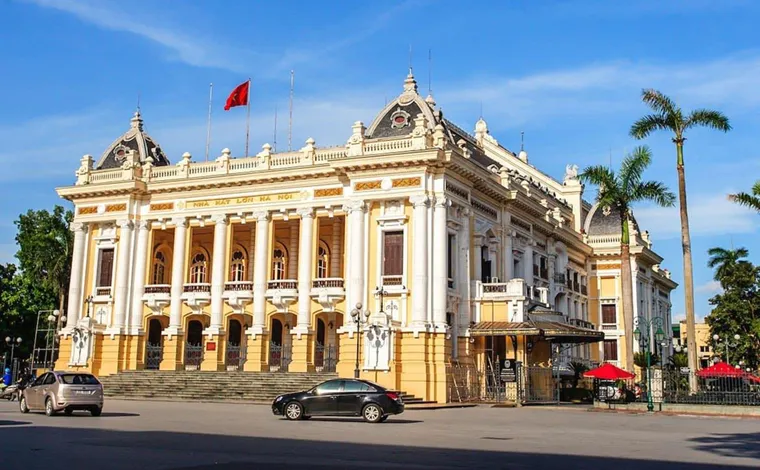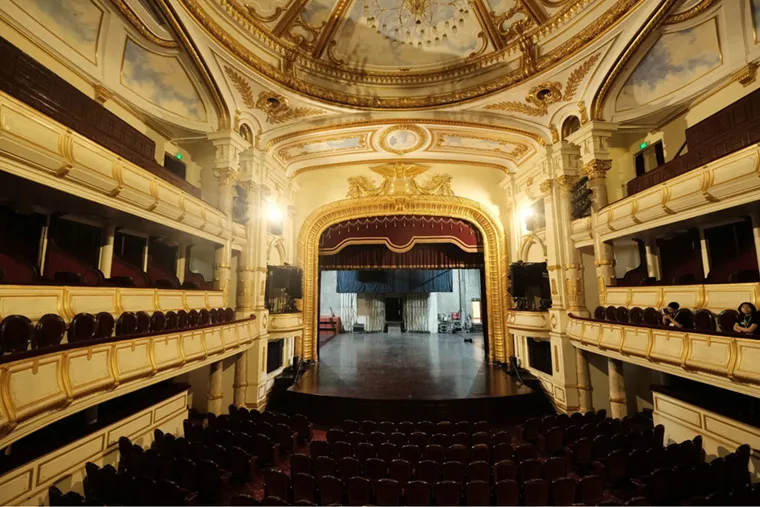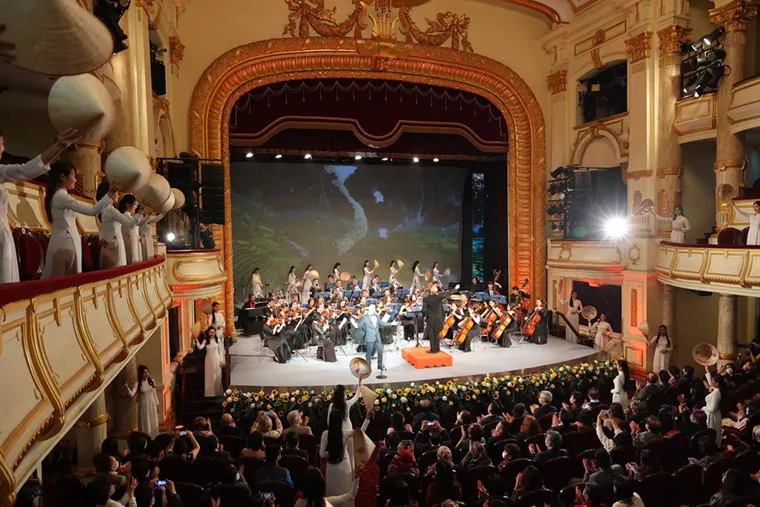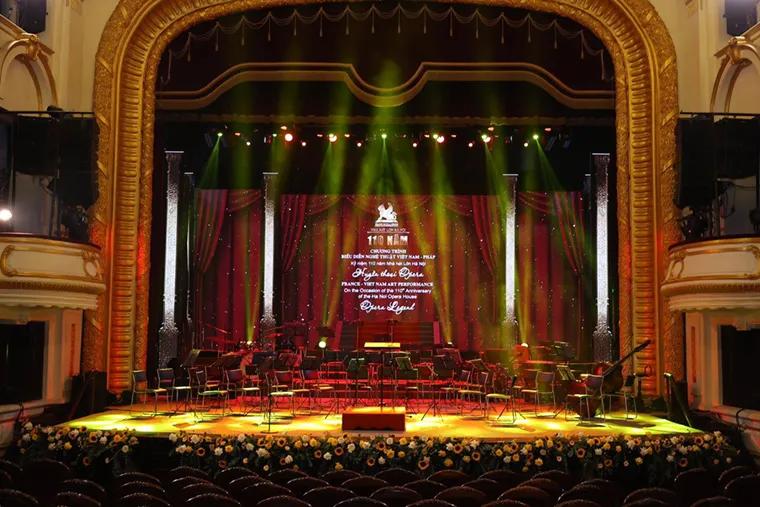Hanoi Opera House: French Architecture in Vietnam
The main content of the article
- 1. The Legacy of Hanoi Opera House - A Journey Through Time
- 2. The Architectural Grandeur - An Ode to French Elegance
- 3. Cultural Significance - A Hub of Performing Arts
- 4. Visiting the Hanoi Opera House - What You Need to Know
- 5. Discovering the Surrounding Attractions
- 6. Practical Tips for an Unforgettable Visit
The Hanoi Opera House is not just a magnificent architectural masterpiece but also a cultural and historical landmark in the heart of Vietnam’s capital. As one of the most iconic symbols of French colonial heritage, this splendid building continues to stand as a testament to Hanoi's vibrant artistic spirit. Whether you're an architecture enthusiast, a culture lover, or a curious traveler, the Hanoi Opera House promises an unforgettable experience.
1. The Legacy of Hanoi Opera House - A Journey Through Time
Built between 1901 and 1911, the Hanoi Opera House is a stunning representation of French neoclassical architecture. Inspired by the famous Palais Garnier in Paris, it was designed by French architects Eugène Ferret and François Lagisquet. The construction took place under the French colonial rule in Vietnam, symbolizing the cultural and artistic aspirations of that era.
Located at No. 1 Trang Tien Street, Hoan Kiem District, right in the heart of Hanoi, the opera house occupies a prime position surrounded by major landmarks and bustling streets. It became not only a venue for artistic performances but also a social hub for the French elite and Vietnamese intellectuals of the time. For visitors arriving at noi bai international airport hanoi, the Opera House is a significant cultural landmark easily accessible from the airport.
In 1945, it served as the site for the first session of the National Assembly of the Democratic Republic of Vietnam, marking its historical significance beyond art and culture. Over the decades, the building has undergone numerous renovations, but its grandeur and elegance remain untouched, preserving its status as a cultural treasure of the capital city.

The magnificent beauty of Hanoi Opera House - Image Source: Fanpage Hanoi Opera House
2. The Architectural Grandeur - An Ode to French Elegance
The Hanoi Opera House is a masterpiece of architectural finesse, showcasing French neoclassical design blended with local aesthetics. The exterior impresses with its grand portico, supported by massive columns, and an elaborate façade adorned with intricate stone carvings and reliefs.
The arched windows and balustrades give it a majestic appearance, while the roof, covered with gray tiles, mirrors the traditional style of French theaters. The striking yellow and white color palette enhances the building’s vintage charm, making it stand out amid the bustling streets of Hanoi.
Inside, the opera house is equally magnificent. The grand lobby greets visitors with marble floors, chandeliers, and elegant staircases leading to the main auditorium. The hall itself is designed to accommodate up to 600 guests, with plush red velvet seats arranged in a semi-circular pattern to provide an unobstructed view of the stage. The ceiling frescoes, reminiscent of European opera houses, add to the luxurious atmosphere, making every performance feel like a royal occasion.

A striking architectural space inside the theater - Image Source: Fanpage Lễ hội thiết kế sáng tạo Hà Nội
3. Cultural Significance - A Hub of Performing Arts
The Hanoi Opera House is more than just a stunning piece of architecture; it is a cultural epicenter where the arts thrive. Throughout its history, it has hosted countless performances ranging from opera and ballet to classical music concerts and traditional Vietnamese folk shows.
The opera house plays a crucial role in nurturing Vietnamese performing arts, bridging Western classical music with indigenous cultural performances. Renowned orchestras, opera troupes, and international artists frequently grace its stage, making it a premier venue for high-quality entertainment in Vietnam.
The building is not only an attraction for tourists but also a favorite among locals, especially during cultural events and national celebrations. Experiencing a live performance here is a profound way to connect with both the artistic and historical essence of Hanoi.

The Opera House plays a vital role in nurturing the nation's performing arts - Image Source: Fanpage Nghệ thuật biểu diễn tại nhà hát Lớn HN
4. Visiting the Hanoi Opera House - What You Need to Know
The Hanoi Opera House is conveniently located within walking distance of Hoan Kiem Lake and the Old Quarter, making it easily accessible from almost any part of the city.
To visit, you can choose between guided tours or attending a live performance, both offering unique ways to appreciate the building’s beauty and cultural significance.
Ticket Information: Purchasing tickets in advance is highly recommended, as performances often sell out quickly, especially during peak seasons and national events. Tickets can be bought directly at the box office or through official online platforms. Prices vary depending on the type of performance and seating location, typically ranging from 300,000 to 2,000,000 VND (~12 - 80 USD).
-
Opening Hours: The opera house is generally open to visitors from 10:00 AM to 5:00 PM on weekdays, but hours may vary based on scheduled events and performances.
-
Dress Code: While there is no strict dress code for guided tours, attending a performance requires smart-casual attire to respect the elegant ambiance of the venue.
-
Guided Tours: For those interested in exploring the architectural beauty and historical stories, guided tours are available. These tours provide insights into the building’s history, architecture, and cultural importance, offering a deeper understanding of its legacy.

A performance night at the opera house - Image Source: Fanpage Nghệ thuật biểu diễn tại nhà hát Lớn HN
5. Discovering the Surrounding Attractions
Given its prime location, the Hanoi Opera House is surrounded by several must-see attractions that complement your cultural journey.
-
Hoan Kiem Lake: Just a short stroll away, Hoan Kiem Lake is the heart of Hanoi, perfect for a leisurely walk or photo session. Visit Ngoc Son Temple on Jade Island for a touch of spirituality.
-
Trang Tien Plaza: Right next to the opera house, this high-end shopping center offers a range of luxury brands and local fashion, perfect for a bit of retail therapy after your cultural exploration.
-
Vietnam National Museum of History: Located just behind the opera house, this museum houses an impressive collection of artifacts that trace Vietnam’s history from prehistoric times to the modern era. To further delve into Hanoi's heritage, consider a visit to the hanoi old city gate, a significant historical landmark.
6. Practical Tips for an Unforgettable Visit
To make the most of your visit to the Hanoi Opera House, keep these tips in mind:
-
Plan Ahead: Check the schedule online and book tickets early to secure your spot for popular performances. When planning your transportation to and from the city center, consider the convenience of Hanoi airport buses.
-
Arrive Early: Get there 15–20 minutes before the show to explore the exterior and take photos.
-
Dress Appropriately: If attending a performance, choose elegant attire to match the sophisticated ambiance.
-
Respect the Venue: Photography inside the auditorium is generally prohibited during performances, so be mindful of the rules.
-
Combine Your Visit: Explore nearby attractions like Hoan Kiem Lake and the Old Quarter to complete your cultural experience.
The Hanoi Opera House stands as a magnificent blend of French elegance and Vietnamese cultural heritage. Whether you attend a performance or simply admire its grandeur, this iconic landmark offers a glimpse into Hanoi’s artistic soul. Make sure to visit and immerse yourself in its timeless charm and historical significance.
|
Joytime - Your Vietnam Journey's Servant Expert Follow us for travel tips, local insights, and exclusive offers:
|

Danish Nguyen
Danish Nguyen is a renowned travel blogger in Vietnam with over 5 years of experience sharing unique travel experiences. With a passion for exploring new places, Danish captures incredible moments and provides readers with valuable tips to discover the beauty of his homeland.


















